U.S. Department of Defense recently reported that China currently has the largest navy in the world.
Aren’t you concerned about which countries are behind the Dragon?
To understand the influence on oceans considering the current heated geopolitics, we have to compile the history of the navy.
Since the sea was navigable, empires from early ages raced to conquer 70% of the earth.
The ability to project navy strength across oceans defined the global influence.
But the question arises, What does the navy do?
A Country’s Navy recruits, trains, organize, and arm up combat-ready maritime forces to win possible naval and amphibious conflicts while maintaining the security in the territorial waters of that country.
The list below is based on data compiled in Global Firepower’s world navy ranking 2023 by the number of offensive and defensive naval assets a country has. These are the top 10 navies in the world 2023:
10. Indonesian Navy
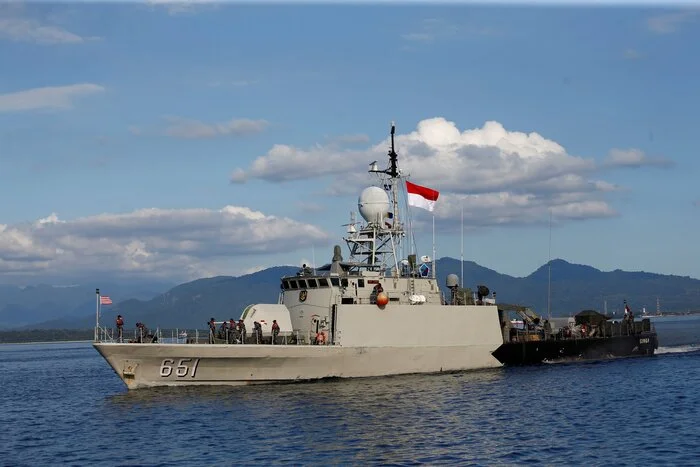
The Indonesian Navy is the biggest navy in Southeast Asia, with approximately 213 ships of all types, including 11 major surface combatants, 72 patrol and coastal combatants, 11 ships for mine warfare, 4 submarines, 30 amphibious assault vessels, and 85 support vessels. It has 75,000 active personnel.
According to the World Defense and Military Monitor (WDMMW) Global Naval Powers Ranking (2023), Indonesia ranks 10th in terms of the total number of warships and submarines with 221 ships.
Modernaziation in 2023:
The Indonesian Navy is upgrading its naval capabilities to better protect its maritime interests and territory.
The Minimum Essential Force plan aims to replenish and modernize the fleet, aiming for 151 vessels (minimum), 220 vessels (standard), or 274 vessels (ideal).
This includes acquiring small-size, modern frigates, and corvettes equipped with anti-ship missiles, reinforced by many Fast Patrol Boats (FPBs) and guided-missile attack craft.
Additionally, Indonesia plans to acquire 12 new diesel-electric submarines.
Indonesia’s maritime boundary claims affect its natural resources sector, including fisheries and oil and gas extraction.
To enhance its naval capabilities, the Indonesian Navy has been conducting joint military exercises with other countries, such as the United States, to enhance at-sea and amphibious warfare capabilities.
However, a lack of resources for national defense is hampering the Navy’s ability to sustain and enhance naval cooperation initiatives.
Local southeastern Asian countries broadly welcomed the Indonesian Navy’s expansion plans as a contribution to regional security (to counter its Northern communist threat).
The country needs more capacity and capability simply to defend its maritime rights rather than assert itself across the region.
While Indonesia has never built a navy strong enough to defend its vast waterways, its current modernization efforts are focused on building a “Green-Water Navy” of 274 ships divided into a “striking force” and a “surface action group.”
With the political will and acquisition of powerful combat platforms, such as the two Danish-built Iver Huitfeldt-class frigates currently on order, Indonesia is making progress toward its modernization goals.
9. Italian Navy
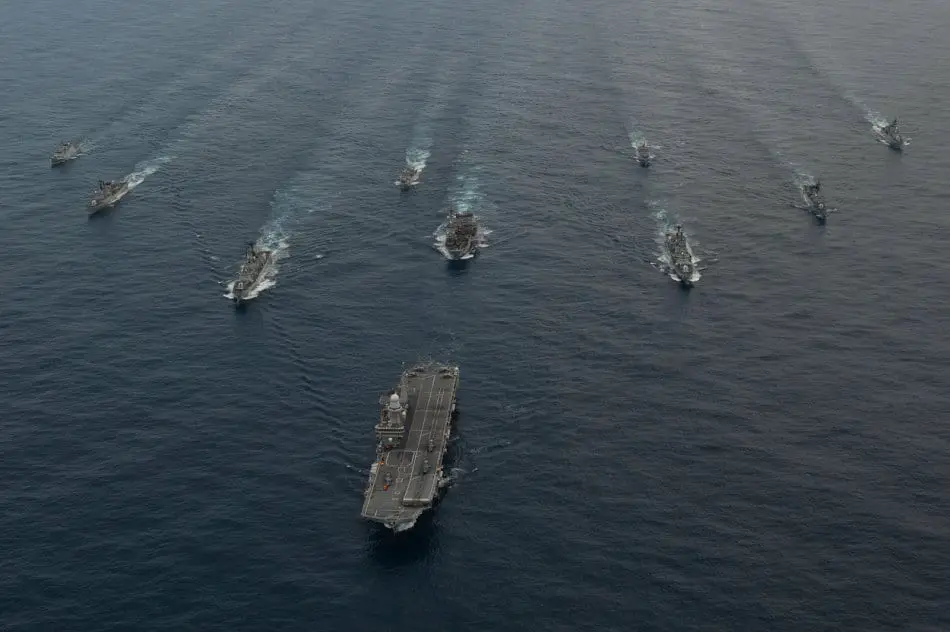
The Italian Navy was known as the Royal Marine before World War II, as the Republic of Italy replaced the Kingdom of Italy.
Italian Navy (officially Marina Militare Italiana) has a naval fleet with some 31,000 active personnel.
The Italian Navy operates warships of all types. They have an aircraft carrier from Cavour-Class, which is also their flagship.
It can handle V/STOL (Harriers and F-35Bs), helicopters, and aircraft systems. The Cavour can transport while holding troops and vehicles as well.
A smaller aircraft carrier named Giuseppe Garibaldi is also in service.
The fleet comprises 2 aircraft carriers, 6 diesel-powered submarines, 3 amphibious assault ships, 4 destroyers, 10 frigates, 5 corvettes, 10 coastal patrol boats, 10 offshore patrolling ships, 4 coastal patrol vessels, and 6 active anti-submarine frigates of Maestrale-class frigate.
The Marine Brigade of Italy (San Marco Marine Brigade) has a strength of 3,800 men, and the Navy recruits the amphibious brigade on 3 amphibious transport vessels of the San Giorgio class.
The Navy built it considering enhanced standards, which could bring more troops compared to the third ship of the San Giusto class.
Italy is reportedly developing a new amphibian attack boat from Trieste.
By 2022, this would replace the light aircraft carrier, Giuseppe Garibaldi.
8. Republic of Korea Navy
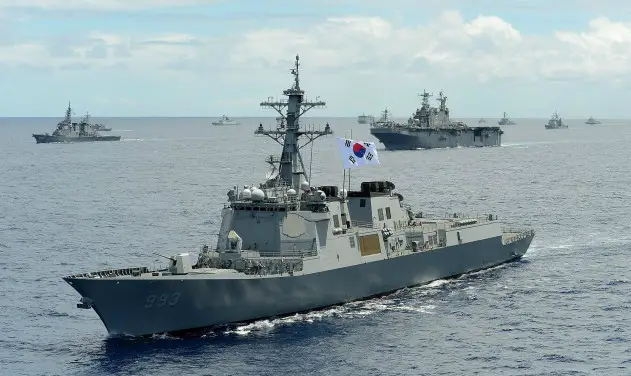
Since the 1990s, South Korea has significantly improved its naval strength to counter China and North Korea, national security threats similar to Taiwan.
But unlike the Taiwanese Navy, which imports many ships from western countries, the South Korean Navy operates every vessel made in their homeland.
Most of them are designed & manufactured by state-owned companies.
Private firms like Hyundai and Daewoo make the rest of the armed vessels.
South Korea has about 70,000 active personnel, which is much more than the combined forces of our predecessors Italian Navy and the Republic of China (Taiwan).
Its naval fleet comprises 23 submarines, 1 amphibious assault ship, 6 landing vessels, 8 landing crafts, 12 destroyers, 14 frigates, 36 corvettes, 11 mine countermeasures ships, and 70 fighter aircraft.
South Korea needs a powerful military to protect itself from its neighbor’s sea-based attacks with a threat on the horizon.
Thankfully, since the Korean War, the South Korean economy has slowly improved, allowing the government to use modern military equipment without worrying about economic constraints.
Based on what is happening in North Korea today, you can expect that the South Korean government will further boost the nation’s coastal defenses.
Considering North Korea’s Navy, The Korean People’s Army Naval Force currently has the second-largest naval fleet in the world.
North Korea possesses 967 ships, including 438 patrol boats, 86 submarine fleets, 25 mine-war vessels, and 10 frigates.
Although South Korean Marines were established many decades ago, it has recently become a powerful ocean force, as the eighth biggest Navy in the world.
7. French Navy
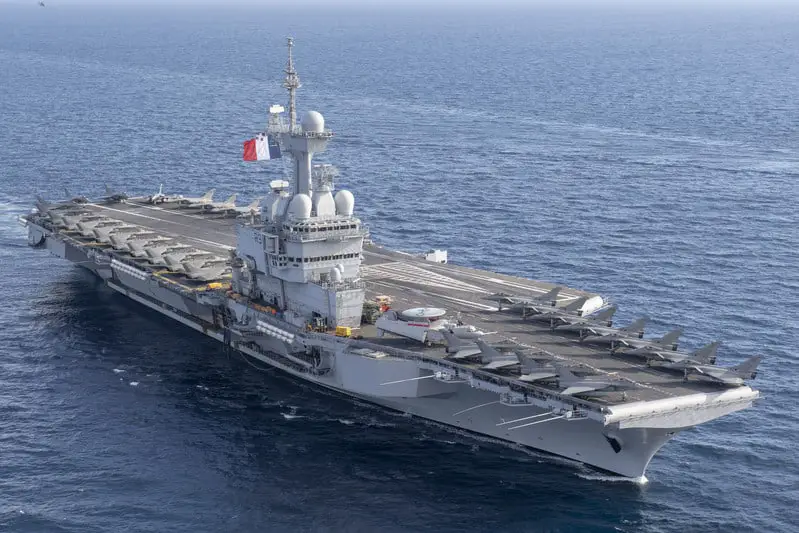
The French Navy (La Royale) was established in 1624 by The Kingdom of France and is one of the world’s oldest naval forces.
The French Navy served a vital role in building the French colonial empire and helping allied forces win both wars.
The fleet comprises about 36,000 working naval officers, about 200 aircraft with a single carrier, 4 submarines, 6 attack submarines with combat ballistic missiles, 3 amphibious warfare ships, 4 air defense destroyers, 5 general purpose frigates, 6 surveillance frigates, 21 patrol vessels, and 18 mine counter-attack warships.
The list also comprises various supporting and assisting ships, including training ships, tugboats, and refueling vessels.
France is also one of the nuclear forces in the world, so it is not surprising that there is such a considerable battle force on the coastline.
As sixth the best Navy in the world, it is defined by its role in intelligence preservation, public protection, crisis prevention, and preventing the threat of possible invasion.
The Marine Nationale comprises four branches.
• Force D’Action Navale
• Forces Sous-marines
• Aeronavale
• Fusiliers marine.
The Naval Force operates many combat ships, including nuclear carriers, nuclear submarines, and frigates.
Among them is the French Navy flagship Charles de Gaulle aircraft carrier, which is a unique class of aircraft carriers.
New frigates will be commissioned to replace destroyers class Cassard and Georges Leygues with Aquitaine class frigates.
6. Indian Navy
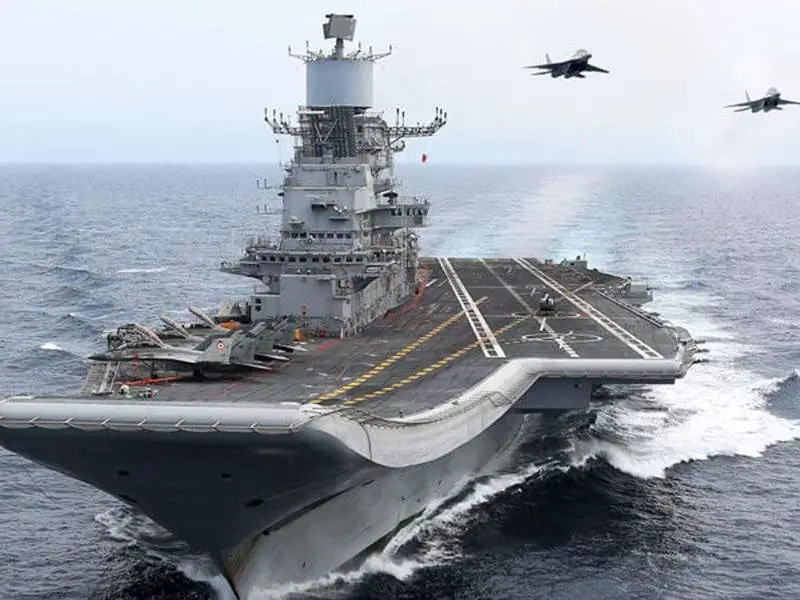
India is slowly but certainly improving the resources in its defense to become a global sea power.
Considering the rising influence of its Chinese neighbor in the Asia Pacific, India and the United States, Japan, and Australia formed an informal strategic alliance known as Quadrilateral Security Dialogue (Quad).
INS Vikramaditya aircraft carrier is the flagship of the Indian Navy (modified Kiev-class aircraft carriers).
This carrier is moderate in terms of the number of naval aviation carrying capacity.
The state-owned company Cochin Shipyard built the first homemade aircraft carrier, INS Vikrant, commissioned in 2013 and is more capable than its Russian-made predecessor.
Both INS Vikrant and INS Vikramaditya have skyrocketed India’s power projection capacity through the Indian Ocean.
The third one, the INS Vishal aircraft carrier (also known as the Indigenous Aircraft Carrier 2), was planned and constructed by the Cochin Shipyard for the Indian Navy.
INS Vishal will be India’s second aircraft carrier and first supercarrier.
11 destroyers are operating in the Indian Navy, including three Kolkata class, 3 Delhi class, and 5 older destroyers in the Rajput class.
Indian Navy had crafted many in modern technology, including three Shivalik and six Talwar missile-guided frigates.
There is also a single frigate of the Godavari class, three older Brahmaputra classes, and 26 corvettes intended to protect coastal Waters.
Indian Navy will soon operate single ballistic missile class submarines, while the second class ship will be commissioned shortly.
These submarines with nuclear power have been developed and incorporated with high secrecy.
Along with diesel-powered submarines, the Indian Navy has two nuclear-powered submarines.
The Indian Navy is modernizing to upgrade its outdated military technology and ramp up the domestic defense industry.
In 2021, Landing Craft Utility (LCU) Mark IV Class was commissioned in the Navy, designed and built by Garden Reach Shipbuilders & Engineers Ltd (GRSE), Kolkata.
These vessels play a primary role in transporting battle tanks, vehicles, troops, and equipment from ship to shore.
Experts often regard this modernization as part of India’s defense plan to develop coastal water security and strengthen its influence in the Indian Ocean.
5. Royal Navy
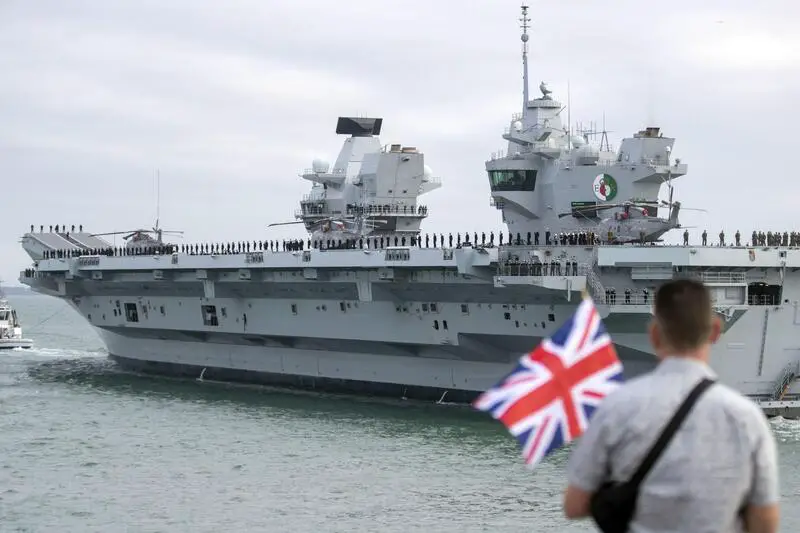
British Empire was the biggest empire in the world that controlled almost all oceans, seas, and territorial waters from the mid-18th century to the early 20th century.
Similarly, the Royal Navy was once the world’s largest navy with a powerful influence still to this day.
It had an unrivaled influence and played a major role in developing the United Kingdom. The United States Navy only surpassed it when the Second World War was over.
Speaking about its current capabilities,
Two Queen Elizabeth class aircraft carriers operate with an initial capability with HMS Queen Elizabeth as the fleet’s lead ship.
British naval aircraft carriers are smaller than American carriers and slightly more prominent than Russian and Chinese ones.
British Navy owns six anti air fighting destroyers, and these vessels patrol vast areas to provide the fleet with air defense.
In contrast to the Daring class destroyers, 13 duke frigates are mostly used for varied roles and anti submarine warfare.
There is a well-respected Royal Marine Commando Brigade of 7,700 personnel in the Royal Navy.
The Royal Marines are the European Union’s most potent naval infantry force (second in the world after the US marines corps).
Additionally, there are two landing ships in class Albion and three logistic landing platform vessels in the Bay class.
Three nuclear-powered submarines are operating in the Astute class.
Three nuclear-powered attacking Trafalgar-class active warships will slowly retire in the coming years.
British also maintain four Vanguard ballistic missile submarines and Tomahawk cruise missiles for all subs.
Each of these ships can carry a maximum of 192 nuclear warheads, and this power is enough to wipe out entire countries at once.
The fleet contains one aircraft carrier, three ballistic missile submarines, six nuclear power submarines, three amphibious vessels, six destroyers, 13 frigates, three offshore patrol ships, 13 minehunters, and 18 fast patrol boats.
The Royal Navy also uses an HMS Bristol destroyer type 82 and an HMS Victory ship of the line.
The latter is noteworthy as the oldest naval vessel ever afloat and serves as the first sea lord’s flagship.
4. Japan Maritime Self-Defense Force
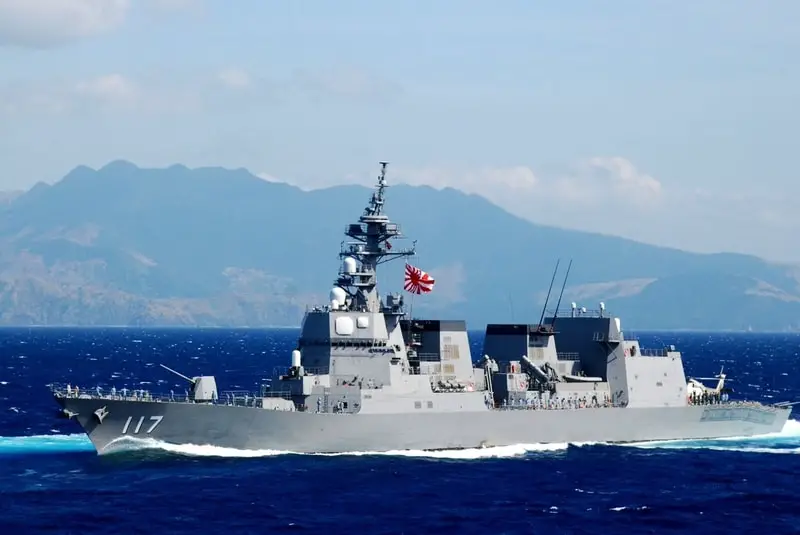
Japanese Navy was officially established a few years after the Second World War, after the Imperial Japanese Navy was dissolved.
Japan Maritime Self-Defense Force (JMSDF) is the maritime warfare branch of the Japan Self-Defense Forces, consisting of 50,800 personnel, 150 ships, and almost 346 aircraft.
The Japan Self-Defense Maritime Force comprises 7 warships, 40 destroyers, 6 frigates, 4 air defense destroyers, 3 landing ships, two landing crafts, 25 counter-attack vessels, six patrol ships, and eight training boats.
Japan recently modernized its marine facilities, just like South Korea, to defend itself from the North Korean, Chinese, and Russian threats.
Recently Japan, Taiwan, and the US formed a trilateral to counter aggressive china’s fleet that projects power in the South China Sea and overall Western Pacific.
The Japan Sea Forces are a Japanese self-defense military unit responsible for Japan’s coastal defenses.
Their Naval expansion is legally limited to military doctrine as a part of the Japanese constitution.
It operates state-of-the-art warships and submarines. In contrast, they keep the Japanese fleet ready and highly efficient.
Therefore, while Japanese navies lost their numbers and tonnage (total million tons) to the Chinese fleet, Japanese warships were more modern and equipped with advanced arms.
The JMSDF has no nuclear powered attack submarines but has around 20 submarines.
As far as Japan does not use nuclear warships, it has built up diesel submarines that have improved its strength and offensive capabilities.
Yet Japan does not have any underwater ballistic missiles or strategic ballistic missiles.
Naval aircraft in Japan comprises about 70 Lockheed P-3C Orions and a dozen Kawasaki Navy P-1s.
3. Russian Navy
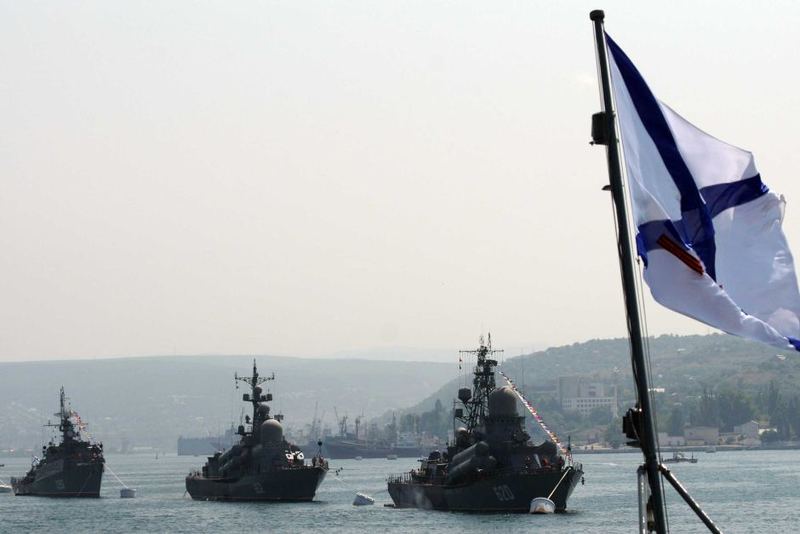
Succeeding from Red Fleet, the Russian Navy was officially established in 1992 following the dissolution of the Soviet Union.
It comprises about 148,000 active personnel and over 300 operational vessels and 300 boats, almost triple the Japan Maritime Self Defense Forces, active staff.
Russia’s naval fleet includes one cargo carrier, one battlecruiser, three cruisers, 13 destroyers, eight frigates, 78 corvettes, 17 submerged SSNs, 22 submarines, and 13 submarines for ballistic weapons, 7 submarines for cruise missiles, 3 submarines for special purposed purposes.
The Russian Navy inherited the fleet from the Soviet Navy after the fall of the USSR.
The Soviet fleet has decreased substantially since the early 1990s with the end of the Cold War and the resulting funding problems.
Cold War remnants are the bulk of its vessels. In the last two decades, the Russian defense has faced problems maintaining its main troops because of its small funding.
Three smaller missile Slava class cruisers offer great anti ship, anti-aircraft (guided-missile destroyer), and antisubmarine warfare capabilities.
While Russia is better known for its strong ground forces (military), its Navy was not as powerful as its western counterparts.
But the time is changed as the modern Russian Navy indicates that Russia is well prepared for sea skirmishes, making it a formidable force.
Still, the Russian Navy falls behind the Chinese Navy (on paper) in overall warship numbers and tonnage.
Russia, however, has several proven ballistic missile submarines, which have been extremely deadly.
It still has the most powerful submarine in the world, the Typhoon-class submarine.
2. United States Navy
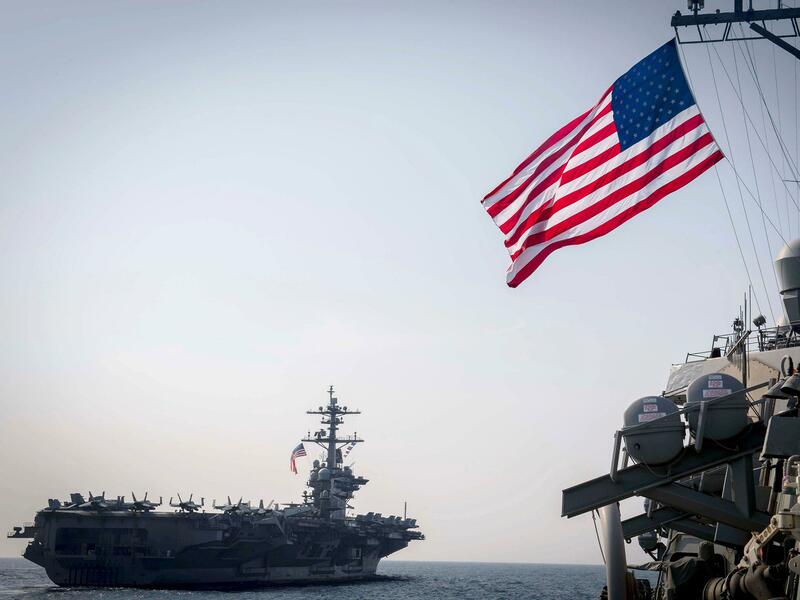
Comparatively, the Chinese navy has a numerical advantage in terms of the total naval fleet, but the US still is the strongest navy in the world of its superior technological edge.
The US shifted its naval functionalities from a possible direct war with the Soviet Union to regional conflicts in the early 1990s following the Cold War.
For lower funding and lack of adequate threat currently, but mainly to the cost of smaller ships, US fleets continue to decline.
In the early 20th century, the US took over the British empire in naval strength.
Thanks to one of our best presidents, Theodore Roosevelt, who employed the Big Stick ideology. The US Navy operates 11 large aircraft carriers with 5th generation technology fighter jets.
There are 21 Commissioned carriers from Nimitz to Gerald R. Ford Class, the largest aircraft carrier, and 3 Tarawa class carriers in reserve.
They can operate fixed wing aircraft, including helicopters, and are nuclear-powered. And each carrier can carry 70 to 80 attack fighter jets or fast planes for reconnaissance.
By law, the American Navy must operate a minimum of 11 aircraft carriers (excluding helicopter carriers).
America Class Amphibious Assault Ships and Wasp Class Amphibious Assault Ships are some of the best warships in the world.
Each of these warships carries a force of approximately 1700-2000 Marines and blinded vehicles and delivers tilt rotors, helicopters, and hovercraft to shore.
US Navy’s USS Zumwalt (DDG 1000) is the largest and most technologically advanced surface combatant with the most powerful guided missile destroyers in the world ever built.
Before joining the Pacific Fleet, this 610-foot long, 15,000-ton behemoth started sea trials in 2015.
The Arleigh Burke class destroyers were designed as multi-mission destroyers.
Capable of launching long range Tomahawk missiles strategically on land, anti-aircraft warfare (AAW) with powerful Aegis radar, and Surface-to-Air Missiles.
You might wonder how many ships are in the US navy?
According to the Naval Vessel Register and published reports, the United States Navy has over 490 ships in both active and reserve operations.
Nuclear-powered attack submarines patrol waters near the United States or far away from the seas, making effective anti-submarine efforts useless.
Nearly 3,700 planes serve the US Navy. Based on carrier aircraft, most of these are multi role fighters of the F/A-18 family and other aircraft associated with them.
(Fun Fact- Technically, the US Navy is the second most powerful air force in the world after the US Airforce, if we can consider the number of total fighter planes and attack helicopters commissioned in the US Navy).
It will probably remain at the top in the foreseeable future, based on how much the US government spends on military equipment.
1. People’s Liberation Army Navy

According to the recent U.S. defense report estimates, China currently has the largest Navy in the world in 2022 in terms of the naval fleet.
The People’s Republic of China navy has rapid growth in its offensive arsenal by building new warships and submarines and building new ships faster than ever.
The Chinese Navy, officially called the People’s Liberation Army Navy, has a strength of about 255,000 active personnel.
China’s naval power is controlled in three Northern, Eastern, and Southern theatres, with each respective headquarters in Qingdao, Ningbo, and Zhanjiang.
The Chinese Navy owns a single Liaoning aircraft carrier commissioned in 2018 and is used primarily as a training ship.
But these newer warships are not as potent as their western or Russian counterparts.
On the other hand, the construction of new advanced warships is growing rapidly, strengthening the Chinese military.
People’s Liberation Army Navy (PLAN) has 350 battle force ships, unlike the U.S. Navy’s 293 ships.
It is expected that about 5 to 6 guidance missile cruisers of Type 055 destroyer will be completed by this year.
People’s Liberation Army Navy quickly arose as one of the world’s powerful maritime forces.
In this article, the ranking is based on the sheer offensive scale, navy news, and the number of ships.
Please share it with your friends on Social media if you liked this post.
[wp_show_posts id=”17086″]
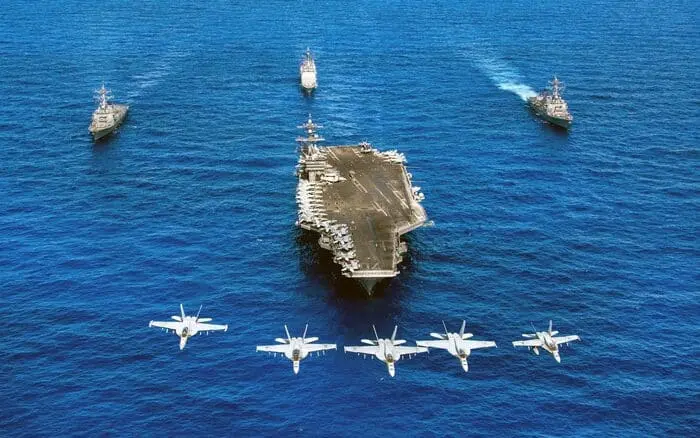
British aircraft carriers are not much larger than US Aircraft carriers, they are 25,000 tons lighter than American carriers like Gerald R. Ford-class aircraft carrier (biggest aircraft carrier in the world) and Nimitz-class aircraft carrier (which makes HMS Queen Elizabeth much smaller).
But yes, they are slightly larger than US Amphibious carriers.
Thank you for valuable information, Robert. I too love Nimitz and the Giant Gerald R. Ford class carriers.
Technically there is no comparison between HMS Queen Elizabeth (65,000 tonnes displacement) and these Sea monsters (100,000 tonnes+ displacement).
Being fully automated, the British carriers are “technically” more advanced, as they can operate on a crew of just 700 personnel. So there is indeed a “comparison”, as the big “old” American carriers require somme 3000 to 4000 personnel…
Both in terms of arm power and global influence US Navy is much more powerful than rest of the navies combined.
In amid of growing tensions with China and other dictatorial regime, US Navy deployed 3 aircraft carriers in Pacific to counter Chinese aggression.
Being an american, I really feel proud of our navy keeps check on protecting democracy and free world for global peace.
God bless America
You mean ur navy interferes in other countries’s buisness right? The US navy is forcing third world countries into submission to protect it’s interests while not giving a damn about what the local people think. If you think about it it’s an example of neo colonialism. Dont get me wrong, i hate china too
Blah blah blah. The US Has done more good for the world than all other nations combined. Not even a debatable. No other nation in history that was thee most dominant power has ever been remotely as benevolent as the USA. I challenge you to prove otherwise.
You’re brainwashed. Your military causes more issues issues than it solves. It also loses almost every war or joins or starts.
Pepsi was once the 6th largest navy in the world
LOL thats true.
It was when top officials of Soviet Russia loved to drink Pepsi and chill out.
But due to some forex glitch rule back then, Soviet ruble couldn’t be exchanged.
Instead, the USSR government paid Pepsi some old Naval Ships of equivalent value.
Pepsi then sold the fleet to a Swedish company for scrap recycling.
Its not true. It is a myth that was popularized by the american media. Pepsi did not recieve the ships bcoz the soviet union fell before they had the chance to send the ships. Even if they got the ships, pepsi’s navy would not even make to the top 30s lol
The Chinese Navy was created to defend the territorial seawaters of China.
Teddy Roosevelt designed the US Navy to promote our American interests, globally.
But these days the Chinese military has moved towards an offensive approach towards its oceanic neighbors in the South China sea.
You may not believe it when listening to western media, but the Chinese only want to secure their trade routes, not military dominance.
But one thing is for sure, Chinese will go to any extent to secure their trade routes in Indo-Pacific.
Yea, protect “their” trade route (including the entire South China Sea), and “their” territory (such as Taiwan). Just like a thief would like to protect your.. um… I mean “their” wallet.
China intends to “take” as much land and sea as it can using its military as an insurance policy. in the past, China was unable to take land or sea territory due to a lack of military capability, but now it is absolutely pursing expansionism.
For many years the United States Navy has far exceeded the Royal Navy.
Probably in 1942–1943, the last time it was comparable was when the Royal Navy finally came out of 1942 and the US was about to implement its massive Building Program to the full.
Still, its carrier aircraft’s superiority in quantity and quality had been an advantage for the US Navy.
British Navy has been substantially reduced from its previous size mainly because the British Empire does not exist as it used to be and, of course, the cost reductions.
If we consider historically, pre-WW2 Britishers used to have the strongest navy in the world ever.
The British military shrank when the Liberal Socialist politicians took control.
What about German Navy or European Maritime Force?
The German Navy is tiny.
10 Frigates, 5 Corvettes, 6 Submarines.
No aircraft carriers, destroyers, warships, cruisers, or nuclear submarines.
Total ships are 65.
Once I reported to my duty squadron, as it was my first time in a carrier, and the ship was in operation.
A carrier ‘s life takes place 24 hours a day.
The flight operations typically take place between early morning and late evening while the night is heavily spent on maintenance.
This does not mean that there are not so many aircraft movements, but maintenance is also not conducted during the day, but it is easier to do at night.
In short, an Aircraft carrier is a completely different kind of beast compared to other defense fleets.
I’ve seen one Nimitz Class aircraft carrier while being on the coast and yes sir, it’s insanely big.
Compared to other countries, the US has a higher number of submarines and most powerful carriers.
“Not for self, but for country”
US Navy ♥
We should not compare a country’s naval strength with just the number of aircraft carriers.
Aircraft carriers can easily be destroyed by hypersonic weapons could make risks outweigh firepower.
Presence of US naval bases in Indo pacific region proves the strength of Uncle Sam in oceans
The Japanese navy does not have a nuclear deterrent. The French and British navies have a continuous at sea nuclear deterrent in the form of nuclear armed submarines. I am assuming that like most of these types of lists, this list is based on the Global Fire Power rankings. Global Fire Power discounts the “fire power” of nuclear weaponry; that is, the ability to deliver a nuclear deterrent. Only a handful of countries have a continuous at sea nuclear deterrent and Japan is not one them. Furthermore, Global Fire Power defines Helicopter Carriers as regular Carriers and does not take into account “Super Carriers, which can carry some 60 aircraft and fly simultaneous sorties.
The Japanese Navy is the 2nd largest in the world, behind the USA. They downplay everything about it.